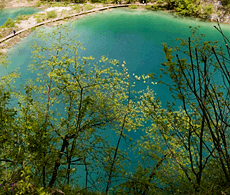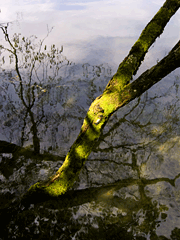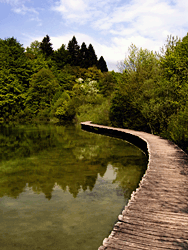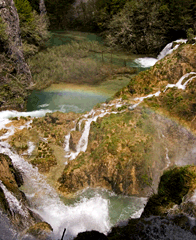Blue Milk
It’s hard to understand, standing on the banks of such crystalline, cerulean lakes, whose dazzling colors come from the mineral rich silt runoff of glaciers, that the largest European conflict since world war two began here, at Like Plitvice Croatia. But indeed this is where the first shots were fired on Easter Sunday in 1991 and the first casualty was a park policeman.
 The Serbs held the area for the duration of the conflict, though it’s difficult to imagine why they wanted it. Lake Plitvice is chiefly notable for its natural beauty and as a gateway to the mountains, hardly a militarily strategic spot since no roads actually run up into, let alone over, the mountains. Nevertheless, here is where it began, though as with all beginnings, it did not really start here, it started with the leaders whose poisoned, greedy hearts and minds dragged the former Yugoslavia into a war no one wanted.
The Serbs held the area for the duration of the conflict, though it’s difficult to imagine why they wanted it. Lake Plitvice is chiefly notable for its natural beauty and as a gateway to the mountains, hardly a militarily strategic spot since no roads actually run up into, let alone over, the mountains. Nevertheless, here is where it began, though as with all beginnings, it did not really start here, it started with the leaders whose poisoned, greedy hearts and minds dragged the former Yugoslavia into a war no one wanted.
 Like most Americans, I never had a real handle on the Bosnia/Croatia/Serbia war. I was dimly aware that The U.S. at some point, with the backing of U.N. (remember when we played by the rules?) launched a campaign of air strikes in Kosovo. For those that like me could never get it sorted, here’s a quick rundown (taken half from guidebooks and half from some Croatians and Serbs I met). The former republic of Yugoslavia was an artificially created state that grew out of the end of world war two and a man named Tito. Tito is an interesting historical figure; he managed with some success to keep one of the most ethnically and religiously diverse countries in the world together for thirty-five years. Naturally there were some iron-fisted clampdowns and not everyone seems to have been fond of him, but in spite of his occasionally brutal tactics he did keep the peace (if at the expense of some). And his tactics were certainly no more brutal than the war that followed his death. Shortly after Tito died in 1980 Yugoslavia was hit by heavy inflation which resulted from Tito’s habit of borrowing foreign money and Yugoslavia’s inability to pay it back.
Like most Americans, I never had a real handle on the Bosnia/Croatia/Serbia war. I was dimly aware that The U.S. at some point, with the backing of U.N. (remember when we played by the rules?) launched a campaign of air strikes in Kosovo. For those that like me could never get it sorted, here’s a quick rundown (taken half from guidebooks and half from some Croatians and Serbs I met). The former republic of Yugoslavia was an artificially created state that grew out of the end of world war two and a man named Tito. Tito is an interesting historical figure; he managed with some success to keep one of the most ethnically and religiously diverse countries in the world together for thirty-five years. Naturally there were some iron-fisted clampdowns and not everyone seems to have been fond of him, but in spite of his occasionally brutal tactics he did keep the peace (if at the expense of some). And his tactics were certainly no more brutal than the war that followed his death. Shortly after Tito died in 1980 Yugoslavia was hit by heavy inflation which resulted from Tito’s habit of borrowing foreign money and Yugoslavia’s inability to pay it back.
Slovenia was the first the break away and is the most ethnically and religiously coherent of the various Balkan states. For the most part Slovenia managed to stay out of the fighting that would soon engulf the area. The Croatians were the next to go, declaring independence in 1991 and finally getting U.N. recognition in 1992. That left Serbia, Bosnia and tiny Kosovo. The trouble was there were a lot of Serbians in Croatia, Croatians in Serbia, Bosnians in Croatia, etc. It’s tough to say there was a good side and bad side in the war that followed, but isn’t it always? The Serbians started the war; the first shot were fired at Lake Plitvice National Park where my parents and I were staying. And yes the Serbians are guilty of ethnic cleansing, rounding up and killing thousands of Croatians. But then the Croatians drove the Serbs out and turned around and engaged in more or less the same ethnic cleansing. War. Everybody loses. Everybody dies.
And so today there are four nations Croatia, Serbia, Slovenia, and Bosnia Herzegovina, where Yugoslavia once existed. [Except, before I was able to get this to press, Montenegro has voted to break away from Serbia, so now there are five. I must publish this before Kosovo does the same.] For the most part the war and its effects are gone. Like Cambodia there is a landmine problem that will continue to exist and kill and main for some time to come, but the tensions seems to have passed and aside from a few bullet riddled buildings and bombed out, caved in roofs, you’d never guess that the largest European war since WWII ended just ten years ago.
Lake Plitvice National Park is a unique geological phenomena formed by two factors: porous karst limestone which absorbs water and erodes quickly, and mineral deposits from since departed glaciers.  As lake water seeped into the Karst, the rock decayed forming a series of lakes and interconnecting waterfalls that cascade through the forests. The national park service has created some trails which pass along the edges of the waterfalls and lakes as they wind their way downhill (or if you’re masochistic and/or not that bright—uphill).
As lake water seeped into the Karst, the rock decayed forming a series of lakes and interconnecting waterfalls that cascade through the forests. The national park service has created some trails which pass along the edges of the waterfalls and lakes as they wind their way downhill (or if you’re masochistic and/or not that bright—uphill).
The waters are both the clearest water I’ve ever seen and yet somehow manage to reflect a color close to bright teal and look a bit like photographs of Banff Canada where similar minerals create the same effect on Lake Louise.
But where Lake Louise is so dramatic as to be almost overwhelming, the natural beauty of Plitvice is quieter and less imposing. There is no overlook or scenic viewpoint with flash popping tourists and calendar worthy photographs, to experience Plitvice you have to get out of the car,  off the road and simply wander the forests in the cool of the morning or evening when the light filtering through the forest is softened by the subtle bending forces of the atmosphere and the forest floor becomes a leaf padded wonderland.
off the road and simply wander the forests in the cool of the morning or evening when the light filtering through the forest is softened by the subtle bending forces of the atmosphere and the forest floor becomes a leaf padded wonderland.
We started at the highest lake and walked downward through cascades of water and reed lined lakeshores, passing at times through the forests where the moss-covered old growth creates a canopy through which sunlight trickles in to form pools of light and shadow forever shifting about as you walk. Strangely there was very little in the way of wildlife. The lakes were choked full of fish, but the forests curiously empty, though I did see a frog lazing in the sunshine near the lakeshore.
As with any Karst area there are a number of caves in Lake Plitvice one of which forms a near vertical chasm through the hillside and can be climbed by means of a series of slippery switch-backing stone staircases. At the right time of day beams of sunlight fall in from above,  illuminating the darker passageways and side tunnels which presumably, with a proper torch could be explored. But I neglected to bring any sort of torch and had to content myself with the main cavern.
illuminating the darker passageways and side tunnels which presumably, with a proper torch could be explored. But I neglected to bring any sort of torch and had to content myself with the main cavern.
The hillsides were covered in the green of spring, the dark shades of firs and the lighter, brighter leaves of beeches and maples. The most remarkable of these trees were the white firs whose branches had nearly florescent tips, the result of fresh spring growth. I spent the first evening in Lake Plitvice studying the white firs around our lodge, trying to make sense of how something so bright could eventually fade to the dark, almost black, green of the inner branches. The newly formed tips were such a striking viridescent contrast to the inner tangle that I couldn’t help but wonder what lay within that nearly impenetrable jumble of darkness nearer to the trunk.
Near the inner tree where the evening light does not penetrate, some hidden gesture of nature as if to remind us that not everything is so easily seen, not everything is in grand sweeping gestures or romantic vistas, sure the highlights capture our attention, but what lies beneath in that dark tangle near the origins? Does the truth perhaps lie in there amongst the dense and inaccessible darkness? Or do I here sound too much like Joseph Conrad obsessed by the darkness of his river and the human heart he saw beating at the end of it?
It occurred to me that my thinking was mistaken, that in fact due to the physics of light,  the inner branches were in fact actually lighter, they appear darker because they reflect less light back to my eye, but without my eye and its entrapments what you might observe is actually a dense forest of light, all that light not given up by the world and therefore seen by us as darkness. Perhaps that’s the reason a number of artists have chosen to start with a completely black canvas and add color on top of it, as if to transcend the limitations of the human eye.
the inner branches were in fact actually lighter, they appear darker because they reflect less light back to my eye, but without my eye and its entrapments what you might observe is actually a dense forest of light, all that light not given up by the world and therefore seen by us as darkness. Perhaps that’s the reason a number of artists have chosen to start with a completely black canvas and add color on top of it, as if to transcend the limitations of the human eye.
But perhaps I am too technical since there is no way to see the world as we could say it really is, because the only means we have to see it are our own eyes, our poor senses cannot reveal this impenetrable universe in which not all is illuminated, not everything makes a sound and much carries the scent of nothing on some solar wind which none of us will ever perceive let alone understand.
I have read that in pure darkness the human eye is sensitive enough to detect a candle at a distance of forty kilometers.  And yet in spite of this remarkable attunement to light, light is our limitation, without it nothing exists for us. Perhaps the inner branches of the firs and pines are merely the unyielding tangle of dead needles and cobwebs and beetles that I imagine and there is no metaphor, no truth which is what drives us out of bed in the vague hint of predawn to stand facing east at the shore of some body of water and wait with such anxious anticipations for the coming of the morning light on the water where, as Flaubert once wrote, “the mind travels more freely on this limitless expanse, the contemplation of which elevates the soul, gives ideas of the infinite, the ideal.”
And yet in spite of this remarkable attunement to light, light is our limitation, without it nothing exists for us. Perhaps the inner branches of the firs and pines are merely the unyielding tangle of dead needles and cobwebs and beetles that I imagine and there is no metaphor, no truth which is what drives us out of bed in the vague hint of predawn to stand facing east at the shore of some body of water and wait with such anxious anticipations for the coming of the morning light on the water where, as Flaubert once wrote, “the mind travels more freely on this limitless expanse, the contemplation of which elevates the soul, gives ideas of the infinite, the ideal.”
Thoughts?
Please leave a reply:
All comments are moderated, so you won’t see it right away. And please remember Kurt Vonnegut's rule: “god damn it, you’ve got to be kind.” You can use Markdown or HTML to format your comments. The allowed tags are
<b>, <i>, <em>, <strong>, <a>. To create a new paragraph hit return twice.